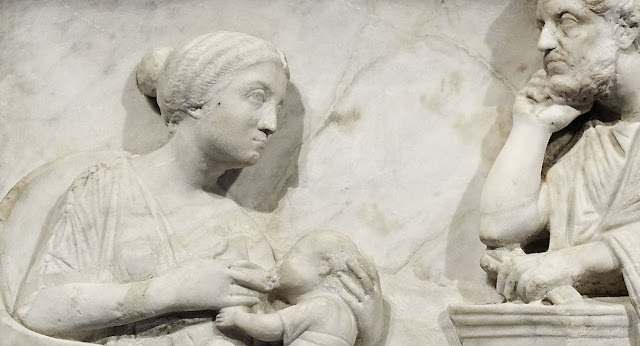The complete power of the Roman father over his children has become proverbial, and the Romans knew that it was an institution peculiar to themselves. It extended not only over all sons and daughters (so long as they had not passed into the manus of a husband), but also over the children of the sons and more remote descendants through males, without any limit other than that imposed by the span of human life.
The oldest male ancestor not only has complete control over the persons of his descendants, even to the extent of inflicting the death penalty on them in the exercise of his domestic jurisdiction, but he alone has any rights in private law. No subordinate member of the family can own any property, and any acquisition that they make go straight to their pater, just as the acquisitions that they make go straight to their pater, just as the acquisitions of a slave become the property of his master. No person, male or female, in potestate can marry without the consent of the pater, and if the sons marry with manus it is the pater who obtains authority over their wives. One limitation there was, presumably from the earliest times: patria potestas has no concern with public law, and a son under power could vote and hold a magistracy just as freely as a paterfamilias. In private law the only limitation, if it can be called one, which we know to have existed at the time of the XII Tables, was the rule that if a father sold his son three times the son was to be free from the father. This rule, as we have seen, was used to make emancipation possible, but it is not known whether emancipation existed already at the time of the XII Tables. It could, clearly, only have existed if the provision concerning the three sales was a restatement of a customary rule.
If the tie between father and child can be artificially broken by emancipation it can also be artificially created by adoption. Desire for continuity of the family was always strong at Rome, and it was of especial importance that there should be a son to carry on the sacra or religious cult of the family. In republican law as we know it there were two entirely different forms of adoption, according as the person to be adopted was one under potestas (i.e. alieni iuris), who was merely to be transferred to another potestas, or a paterfamilias (i.e. a male sui iuris), who was to give up his independence and come under the patria potestas of someone else. In the former case the process was adoptio (in the strict sense) and the rule about the three sales was again pressed into service to break the potestas of the real father. The child (or rather "person to be adopted" –for he might be of any age–) is twice sold to a third party and after each sale manumitted; then he is sold a third time, so that the patria potestas has gone irretrievably. The next step is that the adopting father should bring an action against the third party who now holds the child in mancipio, claiming that he is his son. The action is of course collusive, so that the third party makes no defence and the magistrate adjudges the child to the adopter, into whose patria potestas he thus passes. This is one of a number of cases where the Roman jurists used a collusive action to bring about results for which no direct method was provided by law.
Adrogatio was a more important affair; first there was an investigation by the pontiffs into the desirability of the transaction and then, if they had no objection, the comitia curiata, meeting probably under the presidency of a pontiff, had to give their approval, the institution taking its name from the rogatio or bill which was submitted to them. The reason why there was need here of approval by the religious authorities and by the assembly, whereas none was needed for adoptio, is not difficult to see. Adrogatio, being the adoption of a person sui iuris, meant that a family was extinguished and merged into another. The family might consist only of the person adrogated himself, or of him together with those whom he held in his potestas (who would follow him into the potestas of the adrogator), but in either case it was extinguished, and provision might have to be made for the continuation of its domestic cult. This no doubt was the special interest of the pontiffs.
That adrogatio existed already at the time of the XII Tables is generally assumed, though there is no actual proof; the institution has an archaic flavour about it, and, above all, the use of the comitia curiata, the earliest form of assembly, which ceased to function as a political institution from early republican times, points to the origin of adrogatio at a period before that of the XII Tables. In historical times the comitia curiata was for the purposes of adrogations represented by thirty lictors, one for each of the thirty curiae, so that its approval was a mere matter of form. The preliminary investigation of the pontiffs however remained a reality.
----------
- The law of the family and of succession at the time of the XII Tables
+ Marriage
+ Guardianship
+ The agnatic family
+ Intestate succession
+ Testamentary succession
----------
Source:
Historical introduction to the study of Roman law, H. F. Jolowicz, pages 118 - 120.
